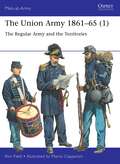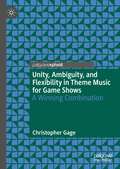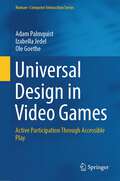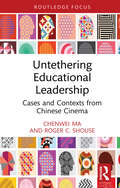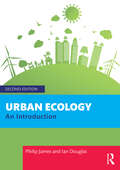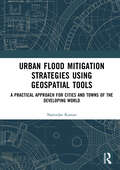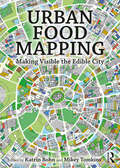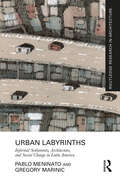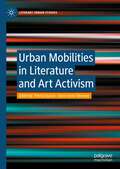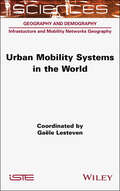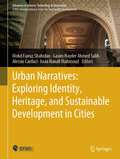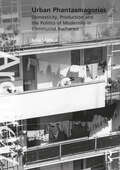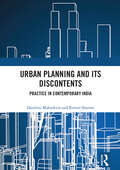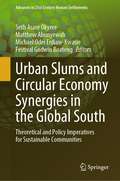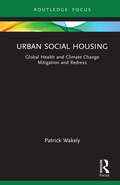- Table View
- List View
The Union Army 1861–65: The Regular Army and the Territories (Men-at-Arms #553)
by Ron FieldThis fully illustrated study investigates the uniforms and equipment of the US regular troops and volunteers from the territories fighting for the Union during the American Civil War.During the American Civil War, the United States Army, pitted against the forces of the fledgling Confederacy, fought to defend and preserve the Union during five long years of bitter conflict. This volume describes and illustrates the uniforms, insignia and personal equipment of the Union Army's regular infantry, artillery, cavalry, and engineers, plus specialists such as US Sharpshooters, Veteran Reserve Corps, Medical Corps, and Signal Corps.This volume also covers the troops fielded by the Territories that fought for the Union. Eight plates of original artwork showing officers and enlisted men of the Union Army are complemented by previously unpublished photographs of soldiers and items of uniform from some of the most comprehensive collections in the United States.
Unity, Ambiguity, and Flexibility in Theme Music for Game Shows: A Winning Combination
by Christopher GageWith flashing lights, bright colors, and big money, game shows have been an integral part of American culture since the days of radio. While the music that accompanies game shows is charming and catchy, it presents two unique, opposing challenges: first, it must exhibit unity in its construction so that, at any point and for any length of time, it is a tuneful, recognizable signifier of the show to which it belongs; at the same time, it must also possess the ability to be started and stopped according to the needs of gameplay without seeming truncated. This book argues that game show music, in particular from 1960 to 1990, deploys a variety of shared techniques in order to manage these two goals, including theme-derived vamps; saturation of motivic material; and harmonic, rhythmic, and formal ambiguity. Together, these techniques make game show themes exciting, memorable, and perfectly suited to their role.
Universal Design in Video Games: Active Participation Through Accessible Play (Human–Computer Interaction Series)
by Adam Palmquist Izabella Jedel Ole GoetheAs participation in game related activities increases around the world and across a larger part of the population, it is obvious that games are not just an entertainment medium for children or young people. Games can be used to accomplish different purposes for different groups of people in society. Developing a universal designed game involves more than adding a cast of diverse characters. Games with universal design, at their core, are experiences that are designed from the ground up to be accessible to everyone – through mechanics, options, and user experience. This book explains the meaning and need for universal design in video games and sheds light on important disciplines. Researchers define a universal designed game as a video game that actively welcomes all players. When players connect authentically with a video game, they’re much more likely to engage with the content. Conversely, when players can’t physically play a game, or don’t see characters that look like them, they feel isolated and miss out on beneficial opportunities to learn and collaborate. Universal design maximizes the impact of playing games, for instance, by ensuring that they’re accessible, empowering and representative for every participant.
Unmögliche Wirklichkeiten: Ikonische Differenz und digitaler Zweifel in fotokünstlerischen Bildern der Gegenwart (Image #238)
by Laura BreedeFotografische Bilder stehen seit jeher im Spannungsverhältnis zwischen Evidenz und Konstruktion. Insbesondere die zunehmend komplexer werdenden Möglichkeiten fotografischer Bildproduktion im digitalen Raum stellen einen vermeintlichen Realitätsbezug in Frage. Basierend auf einer Diskursanalyse philosophischer sowie bild- und medientheoretischer Bildwahrnehmungskonzepte entwirft Laura Breede ein Analyseinstrumentarium, um fotografische Phänomene der Gegenwart im Schwellenbereich zwischen Fiktion und Dokumentation zu fassen. Fotokünstlerische Arbeiten von Andreas Gefeller, Thomas Demand, Andreas Gursky und Michael Reisch lassen sich damit als Unmögliche Wirklichkeiten kategorisieren.
Untethering Educational Leadership: Cases and Contexts from Chinese Cinema
by Chenwei Ma Roger C. ShouseLingdao, the Chinese word for leadership, is rarely used to denote acts of social persuasion that occur outside of contexts of formal rank or status. However, the ubiquity of informal leadership in China raises a number of practical and theoretical questions. Based on an analysis of selected Chinese cinematic works depicting settings of educational practice and policy, the book explores how "Western" understandings of leadership emerge from these texts to form discursive media for social change. It also offers a new understanding of lingdao and leadership; how they represent a natural human desire, regardless of formal rank or position, to mobilize collective will, change minds, and achieve social change. The book will be of interest to professional scholars and graduate students of Chinese culture, educational leadership, mass media, and popular culture.
Untethering Educational Leadership: Cases and Contexts from Chinese Cinema
by Chenwei Ma Roger C. ShouseLingdao, the Chinese word for leadership, is rarely used to denote acts of social persuasion that occur outside of contexts of formal rank or status. However, the ubiquity of informal leadership in China raises a number of practical and theoretical questions. Based on an analysis of selected Chinese cinematic works depicting settings of educational practice and policy, the book explores how "Western" understandings of leadership emerge from these texts to form discursive media for social change. It also offers a new understanding of lingdao and leadership; how they represent a natural human desire, regardless of formal rank or position, to mobilize collective will, change minds, and achieve social change. The book will be of interest to professional scholars and graduate students of Chinese culture, educational leadership, mass media, and popular culture.
Urban Ecology: An Introduction
by Philip James Ian DouglasThis fully revised second edition reflects the great expansion in urban ecology research, action, and teaching since 2015. Urban ecology provides an understanding of urban ecosystems and uses nature-based techniques to enhance habitats and alleviate poor environmental conditions. Already the home to the majority of the world’s people, urban areas continue to grow, causing ecological changes throughout the world. To help students of all professions caring for urban areas and the people, animals, and plants that live in them, the authors set out the environmental and ecological science of cities, linkages between urban nature and human health, urban food production in cities, and how we can value urban nature. The authors explore our responsibilities for urban nature and greening, ecological management techniques, and the use of nature-based solutions to achieve a better, more sustainable urban future and ensure that cities can climate change and become more beautiful and more sustainable places in which to live. This text provides the student and the practitioner with a critical scientific overview of urban ecology that will be a key source of data and ideas for studies and for sound urban management.
Urban Ecology: An Introduction
by Philip James Ian DouglasThis fully revised second edition reflects the great expansion in urban ecology research, action, and teaching since 2015. Urban ecology provides an understanding of urban ecosystems and uses nature-based techniques to enhance habitats and alleviate poor environmental conditions. Already the home to the majority of the world’s people, urban areas continue to grow, causing ecological changes throughout the world. To help students of all professions caring for urban areas and the people, animals, and plants that live in them, the authors set out the environmental and ecological science of cities, linkages between urban nature and human health, urban food production in cities, and how we can value urban nature. The authors explore our responsibilities for urban nature and greening, ecological management techniques, and the use of nature-based solutions to achieve a better, more sustainable urban future and ensure that cities can climate change and become more beautiful and more sustainable places in which to live. This text provides the student and the practitioner with a critical scientific overview of urban ecology that will be a key source of data and ideas for studies and for sound urban management.
Urban Flood Mitigation Strategies Using Geo Spatial Tools: A Practical Approach for Cities and Towns of Developing World
by Narendar KumarThe disastrous effects of floods in urban areas of various Indian cities have been increasing in severity and extent over the past decade. This book explores flood disasters, their impact in world and Indian contexts, assessing vulnerability and risks involved, and systematic use of (GIS)-enabled platforms to map mitigation measures sustainably, with special reference to the metropolitan flood mitigation endeavors. This book balances the theoretical with empirical approaches to form a unique standpoint on the various challenges and possible solutions to urban flooding in India. Through a study of major urban flood incidents, this book analyzes the factors which contribute to the rising risk of flooding with increasing urbanization, population dynamics, growth, and urban sprawl, with particular focus on the cities of Chennai, Mumbai, and Hyderabad in India. It also examines disaster governance on urban floods and legislative prospects of flood disasters through discussions on standing acts, United Nations (UN) directives, and internationally adopted practices and actions, which are applicable in the Indian context. An interdisciplinary study, this book brings together tools and research from various disciplines including geography, urban and regional planning, and GIS. It will be an invaluable resource for researchers, scholars, engineers, students, planners, academicians, and professionals of cross-disciplines to help them resolve the problem of urban flooding. It will also be of interest to the general reader seeking to learn more about disasters, urban flooding, engineering, and GIS.
Urban Flood Mitigation Strategies Using Geo Spatial Tools: A Practical Approach for Cities and Towns of Developing World
by Narendar KumarThe disastrous effects of floods in urban areas of various Indian cities have been increasing in severity and extent over the past decade. This book explores flood disasters, their impact in world and Indian contexts, assessing vulnerability and risks involved, and systematic use of (GIS)-enabled platforms to map mitigation measures sustainably, with special reference to the metropolitan flood mitigation endeavors. This book balances the theoretical with empirical approaches to form a unique standpoint on the various challenges and possible solutions to urban flooding in India. Through a study of major urban flood incidents, this book analyzes the factors which contribute to the rising risk of flooding with increasing urbanization, population dynamics, growth, and urban sprawl, with particular focus on the cities of Chennai, Mumbai, and Hyderabad in India. It also examines disaster governance on urban floods and legislative prospects of flood disasters through discussions on standing acts, United Nations (UN) directives, and internationally adopted practices and actions, which are applicable in the Indian context. An interdisciplinary study, this book brings together tools and research from various disciplines including geography, urban and regional planning, and GIS. It will be an invaluable resource for researchers, scholars, engineers, students, planners, academicians, and professionals of cross-disciplines to help them resolve the problem of urban flooding. It will also be of interest to the general reader seeking to learn more about disasters, urban flooding, engineering, and GIS.
Urban Food Mapping: Making Visible the Edible City
by Katrin Bohn Mikey TomkinsWith cities becoming so vast, so entangled and perhaps so critically unsustainable, there is an urgent need for clarity around the subject of how we feed ourselves as an urban species. Urban food mapping becomes the tool to investigate the spatial relationships, gaps, scales and systems that underlie and generate what, where and how we eat, highlighting current and potential ways to (re)connect with our diet, ourselves and our environments.Richly explored, using over 200 mapping images in 25 selected chapters, this book identifies urban food mapping as a distinct activity and area of research that enables a more nuanced way of understanding the multiple issues facing contemporary urbanism and the manyfold roles food spaces play within it. The authors of this multidisciplinary volume extend their approaches to place making, storytelling, in-depth observation and imagining liveable futures and engagement around food systems, thereby providing a comprehensive picture of our daily food flows and intrastructures. Their images and essays combine theoretical, methodological and practical analysis and applications to examine food through innovative map-making that empowers communities and inspires food planning authorities. This first book to systematise urban food mapping showcases and bridges disciplinary boundaries to make theoretical concepts as well as practical experiences and issues accessible and attractive to a wide audience, from the activist to the academic, the professional and the amateur. It will be of interest to those involved in the all-important work around food cultures, food security, urban agriculture, land rights, environmental planning and design who wish to create a more beautiful, equitable and sustainable urban environment.
Urban Food Mapping: Making Visible the Edible City
by Katrin Bohn Mikey TomkinsWith cities becoming so vast, so entangled and perhaps so critically unsustainable, there is an urgent need for clarity around the subject of how we feed ourselves as an urban species. Urban food mapping becomes the tool to investigate the spatial relationships, gaps, scales and systems that underlie and generate what, where and how we eat, highlighting current and potential ways to (re)connect with our diet, ourselves and our environments.Richly explored, using over 200 mapping images in 25 selected chapters, this book identifies urban food mapping as a distinct activity and area of research that enables a more nuanced way of understanding the multiple issues facing contemporary urbanism and the manyfold roles food spaces play within it. The authors of this multidisciplinary volume extend their approaches to place making, storytelling, in-depth observation and imagining liveable futures and engagement around food systems, thereby providing a comprehensive picture of our daily food flows and intrastructures. Their images and essays combine theoretical, methodological and practical analysis and applications to examine food through innovative map-making that empowers communities and inspires food planning authorities. This first book to systematise urban food mapping showcases and bridges disciplinary boundaries to make theoretical concepts as well as practical experiences and issues accessible and attractive to a wide audience, from the activist to the academic, the professional and the amateur. It will be of interest to those involved in the all-important work around food cultures, food security, urban agriculture, land rights, environmental planning and design who wish to create a more beautiful, equitable and sustainable urban environment.
Urban Labyrinths: Informal Settlements, Architecture, and Social Change in Latin America (Routledge Research in Architecture)
by Pablo Meninato Gregory MarinicUrban Labyrinths: Informal Settlements, Architecture, and Social Change in Latin America examines intervention initiatives in informal settlements in Latin American cities as social, spatial, architectural, and cultural processes. From the mid-20th century to the present, Latin America and other regions in the Global South have experienced a remarkable demographic trend, with millions of people moving from rural areas to cities in search of work, healthcare, and education. Without other options, these migrants have created self-built settlements mostly located on the periphery of large metropolitan areas. While the initial reaction of governments was to eliminate these communities, since the 1990s, several Latin American cities began to advance new urban intervention approaches for improving quality of life. This book examines informal settlement interventions in five Latin American cities: Rio de Janeiro, Medellín, São Paulo, Buenos Aires, and Tijuana. It explores the Favela-Bairro Program in Rio de Janeiro during the 1990s which sought to improve living conditions and infrastructure in favelas. It investigates projects propelled by Social Urbanism in Medellín at the beginning of the 2000s, aimed at revitalizing marginalized areas by creating a public transportation network, constructing civic buildings, and creating public spaces. Furthermore, the book examines the long-term initiatives led by SEHAB in São Paulo, which simultaneously addresses favela upgrading works, water pollution remediation strategies, and environmental stewardship. It discusses current intervention initiatives being developed in informal settlements in Buenos Aires and Tijuana, exploring the urban design strategies that address complex challenges faced by these communities. Taken together, the Latin American architects, planners, landscape architects, researchers, and stakeholders involved in these projects confirm that urbanism, architecture, and landscape design can produce positive urban and social transformations for the most underprivileged.This book will be of interest to students, researchers, and professionals in planning, urbanism, architecture, urban design, landscape architecture, urban geography, public policy, as well as other spatial design disciplines.
Urban Labyrinths: Informal Settlements, Architecture, and Social Change in Latin America (Routledge Research in Architecture)
by Pablo Meninato Gregory MarinicUrban Labyrinths: Informal Settlements, Architecture, and Social Change in Latin America examines intervention initiatives in informal settlements in Latin American cities as social, spatial, architectural, and cultural processes. From the mid-20th century to the present, Latin America and other regions in the Global South have experienced a remarkable demographic trend, with millions of people moving from rural areas to cities in search of work, healthcare, and education. Without other options, these migrants have created self-built settlements mostly located on the periphery of large metropolitan areas. While the initial reaction of governments was to eliminate these communities, since the 1990s, several Latin American cities began to advance new urban intervention approaches for improving quality of life. This book examines informal settlement interventions in five Latin American cities: Rio de Janeiro, Medellín, São Paulo, Buenos Aires, and Tijuana. It explores the Favela-Bairro Program in Rio de Janeiro during the 1990s which sought to improve living conditions and infrastructure in favelas. It investigates projects propelled by Social Urbanism in Medellín at the beginning of the 2000s, aimed at revitalizing marginalized areas by creating a public transportation network, constructing civic buildings, and creating public spaces. Furthermore, the book examines the long-term initiatives led by SEHAB in São Paulo, which simultaneously addresses favela upgrading works, water pollution remediation strategies, and environmental stewardship. It discusses current intervention initiatives being developed in informal settlements in Buenos Aires and Tijuana, exploring the urban design strategies that address complex challenges faced by these communities. Taken together, the Latin American architects, planners, landscape architects, researchers, and stakeholders involved in these projects confirm that urbanism, architecture, and landscape design can produce positive urban and social transformations for the most underprivileged.This book will be of interest to students, researchers, and professionals in planning, urbanism, architecture, urban design, landscape architecture, urban geography, public policy, as well as other spatial design disciplines.
Urban Mobilities in Literature and Art Activism (Literary Urban Studies)
by Patricia García Anna-Leena ToivanenUrban Mobilities in Literature and Art Activism explores the entwinement of mobility and immobility in urban spaces by focusing on their representation in literary narratives but also in visual and performing arts. Across a range of geographical contexts, this volume builds on the new mobilities paradigm developed by literary scholars, sociologists and human geographers. The different chapters employ a cohesive framework that is sensitive to the intersecting dimensions of power and discrimination that shape urban kinetic features. The contributions are divided into three sections, each of which places the focus on a different aspect of urban mobility: Itinerant Subjects, Modes of Transport and Places of Transit, and Urban Liminalities.Chapter 7, "Alienation, Abjection and the Mobile Postcolonial City: Public Transport in Ousmane Sembène’s “Niiwam” and Yvonne Vera’s Without a Name" is available open access under a Creative Commons Attribution 4.0 International License via link.springer.com.
Urban Mobility Systems in the World
by Gaele LestevenUrban Mobility Systems in the World provides insight into the geographical organization of urban mobility systems around the world. These “systems” consist of infrastructure networks, existing transport services and people’s travel practices. Adopting a comparative approach, the book highlights the geographical diversity of mobility systems, based on case studies from Africa, North and South America, Asia and Europe. This multi-disciplinary book is organized into twelve chapters, divided into four parts. The first part gives an overview of urban mobility, and then examines the factors that determine everyday mobility in cities, revealing different travel practices among populations (poor, elderly and children). Parts 2 and 3, respectively, focus on urban public transport (trains, metros, minibuses) and active modes of transport (walking, cycling), and the related infrastructure policies. The final section examines the circulation of urban mobility analysis tools and public policy models
Urban Mobility Systems in the World
by Gaële LestevenUrban Mobility Systems in the World provides insight into the geographical organization of urban mobility systems around the world. These “systems” consist of infrastructure networks, existing transport services and people’s travel practices. Adopting a comparative approach, the book highlights the geographical diversity of mobility systems, based on case studies from Africa, North and South America, Asia and Europe. This multi-disciplinary book is organized into twelve chapters, divided into four parts. The first part gives an overview of urban mobility, and then examines the factors that determine everyday mobility in cities, revealing different travel practices among populations (poor, elderly and children). Parts 2 and 3, respectively, focus on urban public transport (trains, metros, minibuses) and active modes of transport (walking, cycling), and the related infrastructure policies. The final section examines the circulation of urban mobility analysis tools and public policy models
Urban Narratives: Exploring Identity, Heritage, and Sustainable Development in Cities (Advances in Science, Technology & Innovation)
by Mohd Fairuz Shahidan Gasim Hayder Ahmed Salih Alessio Cardaci Israa Hanafi MahmoudThis book engages readers in an enlightening exploration of cities' identities, sustainability, and urban development. Delving into the intricate interplay between art, architecture, and the urban landscape, it offers a compelling analysis of the factors that shape cities and their distinct personalities. The volume uncovers captivating stories of cities as they navigate the delicate balance between heritage conservation and modernity. It highlights innovative strategies employed to preserve historical sites while adapting to the demands of a rapidly changing world. Full of insightful discussions on the impact of cultural lifestyles, the fusion of architectural styles, and the challenges and triumphs of sustainable urban development, it draws upon a diverse range of perspectives and research, inviting architects, urban planners, and scholars to delve into the intricate nuances of cities' identities in the process.With its informative and engaging narrative, this book providesa fresh perspective on cities' identities and offers practical insights into shaping vibrant, livable urban landscapes.
Urban Phantasmagorias: Domesticity, Production and the Politics of Modernity in Communist Bucharest (Architext)
by Iulia StăticăUrban Phantasmagorias examines the legacies of socialist housing in the city of Bucharest during the period of communist rule in Romania. The book explores the manner in which the socialist state reconfigured the city through concrete acts of demolition and construction, as well as indirectly through legal frameworks aimed at the regulation of women’s reproductive agency, in an attempt to materialize its idea of modernity. It follows the effects of this state agenda with a focus on the period between 1965 and 1989 through an investigation of the transformations, representations, meanings, and uses of domestic spaces. The book draws on Walter Benjamin’s concept of phantasmagoria, which provides a critical framework through which it articulates the dynamic relationship between ideology, architecture, and everyday practices, and reassesses their impact upon individual subjectivity and agency. The woman emerges as a central subject of the book, upon whom the phantasmagoric effects of the socialist state’s modernizing agenda have an acute impact at the level of lived domesticity and everyday life. Through a focus on the lived experiences of women, the book illuminates the prismatic effect of the state’s infrastructural and legal intentions, including the ways in which these were subverted through women’s lived bodily experiences of the home. The book establishes, both theoretically and through the concrete case of the city of Bucharest, the methodological significance of Benjamin’s notion of phantasmagoria as an epistemological approach to a modern communist cityscape. Urban Phantasmagorias is an important contribution to scholarship in architectural history and theory, urban and gender studies, and post-socialist and Eastern European studies.
Urban Phantasmagorias: Domesticity, Production and the Politics of Modernity in Communist Bucharest (Architext)
by Iulia StăticăUrban Phantasmagorias examines the legacies of socialist housing in the city of Bucharest during the period of communist rule in Romania. The book explores the manner in which the socialist state reconfigured the city through concrete acts of demolition and construction, as well as indirectly through legal frameworks aimed at the regulation of women’s reproductive agency, in an attempt to materialize its idea of modernity. It follows the effects of this state agenda with a focus on the period between 1965 and 1989 through an investigation of the transformations, representations, meanings, and uses of domestic spaces. The book draws on Walter Benjamin’s concept of phantasmagoria, which provides a critical framework through which it articulates the dynamic relationship between ideology, architecture, and everyday practices, and reassesses their impact upon individual subjectivity and agency. The woman emerges as a central subject of the book, upon whom the phantasmagoric effects of the socialist state’s modernizing agenda have an acute impact at the level of lived domesticity and everyday life. Through a focus on the lived experiences of women, the book illuminates the prismatic effect of the state’s infrastructural and legal intentions, including the ways in which these were subverted through women’s lived bodily experiences of the home. The book establishes, both theoretically and through the concrete case of the city of Bucharest, the methodological significance of Benjamin’s notion of phantasmagoria as an epistemological approach to a modern communist cityscape. Urban Phantasmagorias is an important contribution to scholarship in architectural history and theory, urban and gender studies, and post-socialist and Eastern European studies.
Urban Planning and its Discontents: Practice in Contemporary India
by Darshini Mahadevia Rutool SharmaThis book, the first of its kind, introduces various aspects of urban planning in India and contributes towards debates on changes required in the current practice. Urban planning in India means many things to city residents and is used generically to include all interventions in the cities, such as public policy design, institutional design, spatial and territorial plans, infrastructure plans, public administration, community participation, and their implementation through programmes, schemes, and projects. While urban planning is expected to meet the global development agendas of equitable and just urbanisation, climate change and sustainable development goals (SDGs), in practice it has largely remained confined to statutory spatial planning represented by ‘Master Plan’ or ‘Comprehensive Plan’. This volume delves into this world of urban planning as critical insiders to see how it works in India, analysing the city level spatial plans, the Master or Development Plans, of select cities to assess whether these are capable of addressing the global agendas and coordinate with all other plans prepared for the city. It examines whether it would work in reference to the contemporary issues, SDGs, and global agendas, and discusses strategies on how to make it work better. It also deals with each of the above stated criticisms of the practice and examines the debates, data, approaches, agendas, plans, and the future of urban planning in India. This book comes in at a time when the urban planners and policy makers have themselves begun to discuss a need to relook at urban planning practices and tools to meet the future requirements of urbanisation in India. It will be a useful reference volume for the students, scholars and practitioners alike, and be of interest to researchers and students of urban planning, architecture, public administration, civil engineering, geography, economics, and sociology. It will also be useful for policy makers and professionals working in the areas of town and country planning.
Urban Planning and its Discontents: Practice in Contemporary India
by Darshini Mahadevia Rutool SharmaThis book, the first of its kind, introduces various aspects of urban planning in India and contributes towards debates on changes required in the current practice. Urban planning in India means many things to city residents and is used generically to include all interventions in the cities, such as public policy design, institutional design, spatial and territorial plans, infrastructure plans, public administration, community participation, and their implementation through programmes, schemes, and projects. While urban planning is expected to meet the global development agendas of equitable and just urbanisation, climate change and sustainable development goals (SDGs), in practice it has largely remained confined to statutory spatial planning represented by ‘Master Plan’ or ‘Comprehensive Plan’. This volume delves into this world of urban planning as critical insiders to see how it works in India, analysing the city level spatial plans, the Master or Development Plans, of select cities to assess whether these are capable of addressing the global agendas and coordinate with all other plans prepared for the city. It examines whether it would work in reference to the contemporary issues, SDGs, and global agendas, and discusses strategies on how to make it work better. It also deals with each of the above stated criticisms of the practice and examines the debates, data, approaches, agendas, plans, and the future of urban planning in India. This book comes in at a time when the urban planners and policy makers have themselves begun to discuss a need to relook at urban planning practices and tools to meet the future requirements of urbanisation in India. It will be a useful reference volume for the students, scholars and practitioners alike, and be of interest to researchers and students of urban planning, architecture, public administration, civil engineering, geography, economics, and sociology. It will also be useful for policy makers and professionals working in the areas of town and country planning.
Urban Slums and Circular Economy Synergies in the Global South: Theoretical and Policy Imperatives for Sustainable Communities (Advances in 21st Century Human Settlements)
by Seth Asare Okyere Matthew Abunyewah Michael Odei Erdiaw-Kwasie Festival Godwin BoatengThis book takes a theoretical and empirical distance from urban slums/low-income settlements as a threat to environmental sustainability and recast them as places where environmentally rehabilitative and circular practices occur—drawing on the theoretical lens of the circular economy (CE). CE is defined as regenerative system that minimizes waste, emission, and energy leakage by slowing, closing, and narrowing material and energy loops. In principle, CE departs from the traditional linear model of take-make-use-dispose. As conceived in urban contexts, circular cities offer possibilities to regenerate natural systems, design out waste, and keep products in use. While the CE key principles of reduce, repair, and reuse are essential to the sustainable and inclusive interventions in urban slums, there is lack of case studies exploring the role of place and agency, especially the slum living-CE nexus in global south contexts. In inequitable urban transitions, a nuanced understanding of thesynergies between urban slums and the circular economy is not only theoretically relevant for reconceptualizing the slum in urban sustainability discourses but also exert policy and practice ramifications to decidedly figure out how the urban slum phenomenon can foster the sustainable and inclusive development of marginal areas through contextual and people-centered initiatives.
Urban Social Housing: Global Health and Climate Change Mitigation and Redress
by Patrick WakelyThis book proposes operational approaches to public sector support to community-led development of urban low-income group social housing in the prevailing and medium-term. Within the context of mitigating and redressing the existential threats of climate change and global pathogenic transmission, building on current concerns of global heating and the lessons learnt from the 2020-22 COVID-19 pandemic, the book closely examines recent examples from a wide international range of countries and cities from the Sri Lanka experience to Arab States of the Middle East and the Andes. Topics include maintenance and management of public sector housing, poverty alleviation objectives, climate change mitigation, housing density, local land management and planning, land rights, affordable housing markets, and international governance and administration, ultimately pointing to the universal need for institutional, organisational and human skills development and the compilation and dissemination of operationally successful examples of participatory partnerships for affordable social housing. The book will be of interest to researchers, instructors, practitioners, and students of urban development, housing, environmental design, land-use planning, public administration and environmental health engineering.
Urban Social Housing: Global Health and Climate Change Mitigation and Redress
by Patrick WakelyThis book proposes operational approaches to public sector support to community-led development of urban low-income group social housing in the prevailing and medium-term. Within the context of mitigating and redressing the existential threats of climate change and global pathogenic transmission, building on current concerns of global heating and the lessons learnt from the 2020-22 COVID-19 pandemic, the book closely examines recent examples from a wide international range of countries and cities from the Sri Lanka experience to Arab States of the Middle East and the Andes. Topics include maintenance and management of public sector housing, poverty alleviation objectives, climate change mitigation, housing density, local land management and planning, land rights, affordable housing markets, and international governance and administration, ultimately pointing to the universal need for institutional, organisational and human skills development and the compilation and dissemination of operationally successful examples of participatory partnerships for affordable social housing. The book will be of interest to researchers, instructors, practitioners, and students of urban development, housing, environmental design, land-use planning, public administration and environmental health engineering.
